Protecting Your Home and Family from Moths
While moths do not pose a health risk, they are a pest in homes because of the severe damage their larvae cause to clothes, fabrics, furs, leather and carpets.
This damage may continue for many weeks after moth caterpillars have hatched. Serious harm may have been done before numbers of flying moths are seen and so prevention of a moth problem is important.
While a minor infestation of moths can be dealt with using DIY products, an established moth problem is likely to require professional assistance.
Signs of a Moth Problem
Often the first sign of a moth problem will be damage to fabrics but there will usually be other indicators:
- adult moths (often crawling rather than flying)
- maggot-like larvae (moth caterpillars)
- the silken tubes or cases in which moth larvae live
- pupae (silk cocoons) in which larvae turn into moths
Please note, another common cause of damage to carpets or fur may be due to fur beetles or carpet beetles rather than moths. Please refer to our guide to carpet beetles for further information.
Identifying Moths
There are four common species of moth infestation in the home:
Common Clothes Moth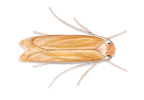
- Adults 6-8mm with straw-coloured wings and no markings
- Larvae creamy white with a brown head and up to 10mm long
- The moth larvae make irregular holes in fabrics
Case Bearing Clothes Moth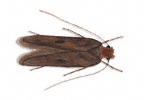
- Found particularly with imported animal fabrics
- Adults 6mm long with a dark-buff colour and three faint spots
- Creamy-white larvae up to 10mm
- Makes more regular holes in fabric than common clothes moth
Brown House Moth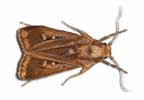
- adults 8-14mm and brown with three or four darker spots
- Larvae up to 20mm, off-white with brown head
- Larvae feed on a wide range of animal textiles including wool, leather and feathers
White Shouldered House Moth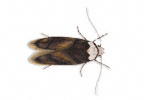
- adults 6-10mm with a white head and mottled wings
- Larvae up to 12mm, cream coloured with red-brown head
- Larvae scavenge on wide range of food. Less damaging to textiles than clothes or brown house moths.
How to keep moth problems away
It is difficult to keep moths from entering an open window or door, although it is advisable to draw the curtains or use a fly screen when windows are open at night, when moths will be attracted to lights.
Once inside, moths lay eggs in dark and rarely disturbed areas where clothes or other textiles are stored.
High risk areas include spare rooms, under beds and infrequently used cupboards or wardrobes. Lofts are also at risk because moths are attracted to bird nests that may be in the eaves of the house.
Dirty or soiled clothing is particularly attractive to moths, so always clean clothes before storing them.
Where textiles are to be stored for a period of time, keep them in sealed plastic bags or suitcases.
Ensure hidden areas such as under furniture are regularly vacuumed to remove moth eggs before they hatch. This is particularly important if there has been a previous infestation or if you have noticed increased levels of moth activity.
| Common Name | Scientific Name |
|---|---|
| Pennsylvania Ground Beetle | Harpalus pensylvanicus DeGeer |
| Murky Ground Beetle | Harpalus caliginosus (Fabricius) |
| Bigheaded Ground Beetle | Scarites subterraneus Fabricius |
| Seedcorn Beetle | Stenolophus lecontei Chaudoir |
| Longnecked Ground Beetle | Colliuris pensylvanicus (Linneaus) |
| Caterpillar Hunter | Calosoma scrutator Fabricius |
| Eastern Snail Eater | Scaphinotus elevatus Fabricius |
| Common Black Ground Beetle | Pterostichus spp. |
Ground beetles are occasionally a nuisance indoors by their presence. Homeowners may confuse these beetles for cockroaches, carpet beetles, woodboring beetles or some other household structural pest. Others are simply curious about these insects after finding them outdoors under stones, logs, boards and similar places. Some beetles are attracted to lights and enter the home by crawling through small openings and cracks in windows, doors, foundations, etc. Ground beetles normally live outdoors and do not establish themselves indoors. They are not dangerous to humans, domestic animals (pets), structures or household items. If handled, some large beetles will pinch fingers with their strong mandibles (jaws) and emit noxious defensive odors.
Identification
Adult ground beetles, referred to as "Carabids," are 1/16 to 1-3/8 inches (12 to 35 mm) long, somewhat flattened, sometimes elongate, with threadlike antennae (11-segmented), narrow head (projects forward), and hard wing covers meeting in a straight line at the center of the back with numerous fine, parallel ridges running lengthwise. These active insects, with long legs, large eyes and strong sickle-like mandibles, run rapidly, and are active mostly at night (nocturnal). Ground beetles are usually black though many are brilliantly colored or enhanced by iridescent, metallic blue, green, purple, reddish or other bright markings. Many species are difficult to distinguish. These insects (predators) feed on other harmful insects and are regarded as very beneficial to agriculture. Larvae are elongate and wormlike in appearance with powerful prominent mandibles. They vary from dirty white to dirty yellow to almost black.
Life Cycle and Habits
There are about 2,500 known species of ground beetles in North America. These active insects are usually found on the ground under rocks, logs, leaves, bark, decomposing wood and other debris on the ground. When disturbed, beetles run rapidly but seldom fly. Most hide during the day and feed at night. Both adults and larvae are considered beneficial since they feed on larvae of many harmful insects. Some are considered pests when feeding on seedlings of crops planted in moist soil in early spring. Larvae usually are not seen whereas adults may be found on the ground underneath night lights. Eggs are normally laid singly in the soil and hatch into elongate larvae tapered toward the end. They have a large head directed forward. Pupation occurs in the soil. The life cycle of most species is usually completed within a year, although adults may live 2 to 3 years or longer. Some adults are attracted to lights and will feed on the crushed remains of their own kind that have been stepped on or run over. Many ground beetles exude or expel foul-smelling secretions that are used to repel their enemies. Some feed on snails and slugs.
Indian Meal Moth
The Indian Meal Moth is the most common pantry pest found in homes and apartments. Found in a wide variety of food items including flour, cereal, nuts, grains, chocolate, birdseed and dried pet foods. This pest usually enters homes in boxes or bags of infested foods.
Quick Facts...
- Indian meal moth is a small, grayish-brown moth common in many homes. The caterpillar stage feeds on nuts, herbs, coarsely ground grains, and other pantry items.
- The first stage of control is to identify all potential sources of infestation in a home.
- Infested materials should be discarded, promptly used up, or treated with heat or cold to kill insects found in the food. A thorough clean-out of all food sources is critical to managing Indian meal moth.
- Storing items in insect resistant containers or in cold storage can prevent reinfestation.
Life Cycle
Adult females deposit up to 300 eggs on or near food materials. Within two weeks larvae hatch and begin actively feeding. As they move they spin silken threads throughout the infested foods, which may become matted with webbing. Larvae feed for approximately two weeks until fully grown and select a pupation site (cracks and crevices, pantry walls, ceilings) where they spin cocoons. Transformation to pupae occurs, and adults emerge in about 30 days. The entire life-cycle requires 4-6 weeks to complete and there may be five overlapping generations per year, depending on temperature.
Control Measures
Prevention
Remove objects where beetles can hide such as leaf piles, old boards, rotting logs, stone piles, firewood piles, etc. around house entrances. Caulk and screen potential entry ways into the home. Since many beetles are attracted to lights, subdue the lighting around windows and doors by using less attractive (to beetles) yellow or sodium vapor light bulbs. Avoid excessive lighting directly upon the house during the spring when beetles are abundant. Indoor lights should not shine directly out of door or window openings. Colored walls that do not reflect light are preferable to glossy white. Small numbers of live beetles found indoors can be easily collected by broom and dustpan and relocated outside far from the house since these predators are helpful in agriculture. Collect dead and dying beetles with a vacuum cleaner and proper attachments. Take extra care to preserve these valuable predators.
Insecticides
Indoors, if necessary, sprays or dusts of pyrethrins or bendiocarb (Ficam D) can be applied around doors and windows and other places where beetles might enter. Outdoors, perimeter (barrier) sprays of diazinon, chlorpyrifos (Dursban) or pyrethroids applied to the house foundation, doorways, window sills and soil or vegetation, 2 feet up and 6 to 10 feet out, can be helpful. Dusts of pyrethrins plus amorphous silica gel (Drione), bendiocarb (Ficam D) or pyrethroids, as a perimeter treatment, are useful. Only the licensed pest control operator or applicator can use bendiocarb (Ficam W or Plus), pyrethrins plus amorphous silica gel (Tri-Die) and propetamphos (Safrotin EC or Dust). Before using any insecticide, always read the label, and follow directions and safety precautions. It is much better to use preventative practices than insecticides. Avoid chemical control if possible.
Murky Ground Beetle (23 mm)
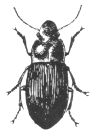
Adults are about 1 inch long, oblong, flattened and dull or reddish black with the wing covers deeply striated. They have brown antennae and black legs. Larvae are black with a reddish head and the body tapered with 2 long cerci (slender paired appendages). Adults feed on the larvae of Colorado potato beetle and others, ragweed seeds and occasionally damage ripening strawberries, probably in search of needed water. They are very common and attracted to lights.
Longnecked Ground Beetle (7.5 mm)
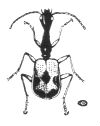
Adults are nearly 5/16 inch long, head and thorax black (unusually slender) with the rest of the body much broader. Wing covers are reddish-brown, each with 3 black spots. They are cut off squarely behind and have tiny pits in rows above. Adults are found on vegetation; larvae in moist soil near cultivated fields and marshes.
Eastern Snail Eater (18 mm)

Adults are nearly 1 inch long and black with pale bluish, purplish, or violaceous reflections. Wing covers are striate and punctate. It is found in moist areas, under leaves, rocks and logs in forests and lowlands. They feed on snails and slugs at night.
Bigheaded Ground Beetle (20 mm)
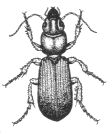
Adults are about 3/4 inch long, shiny, pitch black, with antennae slightly paler, wing covers rather deeply striated, a scarcely punctate head, very broad, and large jaws. They are commonly found in burrows, under stones and in damp soil.
Seedcorn Beetle (7.5 mm)

Adults are 5/16 inch long, light or yellowish-brown bodied with a broad black stripe on each wing cover. The head is black while the antennae and legs are light brown and there are shallow furrows on the wing covers. This beetle is very strongly attracted to lights and large numbers are captured in light traps in early spring. They can cause some injury to seed corn and sorghum planted in wet soils or under conditions which retard rapid germination.
Caterpillar Hunter (30 mm)
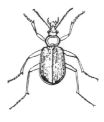
Adults are 1 to 1-3/8 inches long, with violaceous luster on sides of head and thorax, which are blue-black, legs black with bluish luster, wing covers metallic green with red margins, finely striated. This handsome beetle can climb trees in search of prey. It feeds on tent caterpillars, gypsy moth caterpillars and pupae, and other forest caterpillars. It is strongly attracted to lights.
Pennsylvania Ground Beetle (16 mm)
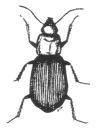
Adults are about 5/8 inch long, shiny black with the underside orange and wing covers deeply striated (furrowed). This common species is numerous in pastures, cultivated fields, and open ground. It feeds on caterpillars (cutworms and armyworms) and seeds. However, they will attack ripening strawberries lying on the ground. Both ripening and green berries may be damaged with the skin broken and the entire surface eaten.
Common Black Ground Beetle (10 to 15 mm)
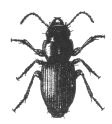
Adults are from 1/2 to 5/8 inch long, elongate, shiny black with prominent, lengthwise grooves on the wing covers.

 Ant Control
Ant Control Bed Bugs
Bed Bugs Bees
Bees Cockroaches
Cockroaches Termite
Termite Flies
Flies Wild Life Removal
Wild Life Removal Mice & Rats
Mice & Rats Fleas
Fleas